|
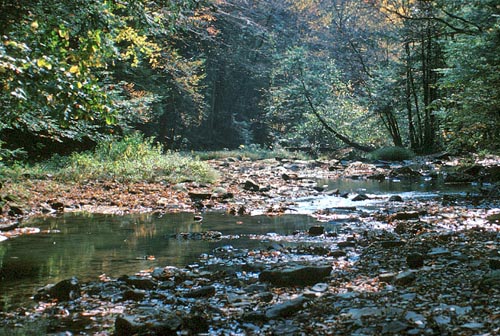
Mill Creek, Pennsylvania |
|
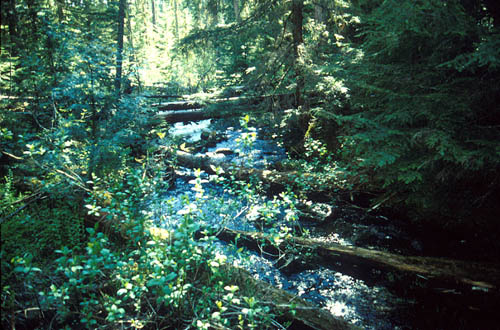
First-order stream - Montana |
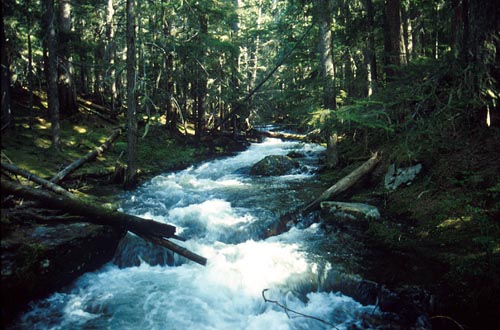
First-order stream - Montana |
|
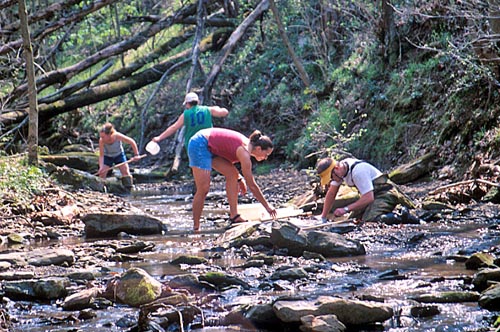
First-order
stream - Washington County, Ohio |
Headwater streams: The smallest permanent streams in an area
are called first-order, or headwater streams. In forested
areas, at least, these streams are often completely shaded, the streambed is
often blocked by fallen timbers, and the food webs are based on the huge
input of leaves and woody debris from the surrounding forests.
Gradients may be steep, and the streams may flood during snowmelt in the
spring (above). At other times of the year, however, the forest canopy
and porous soils of the forest floor absorb sudden downpours and flooding is
thus minimized. The intact forest also releases water to the stream
slowly and steadily, so that flow is maintained even during short dry
periods. The invertebrate fauna is usually dominated by shredders,
organisms capable of feeding on the decaying leaves and woody debris.
In-stream production by algae is minimized due to the forest cover, although
in deciduous forests there may be such production in the spring before the
trees leaf out (see the picture to the left and the picture below).
Fish may well be absent; their role as predators taken over by salamanders
and some insect species.
|
|
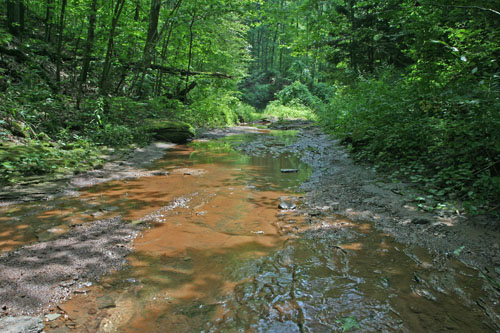
First-order
Stream , Broughton Nature Preserve, Washington County, Ohio |
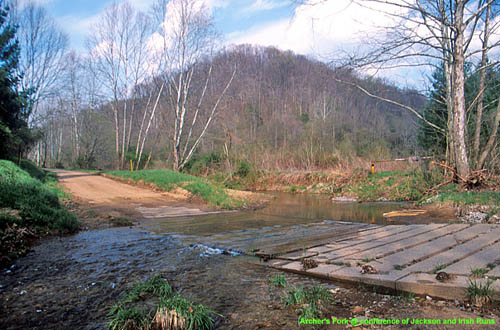
Junction of two First-order
streams (Jackson and Irish Runs) to form a second-order stream (Archer
Fork), Washington County, Ohio. |
|
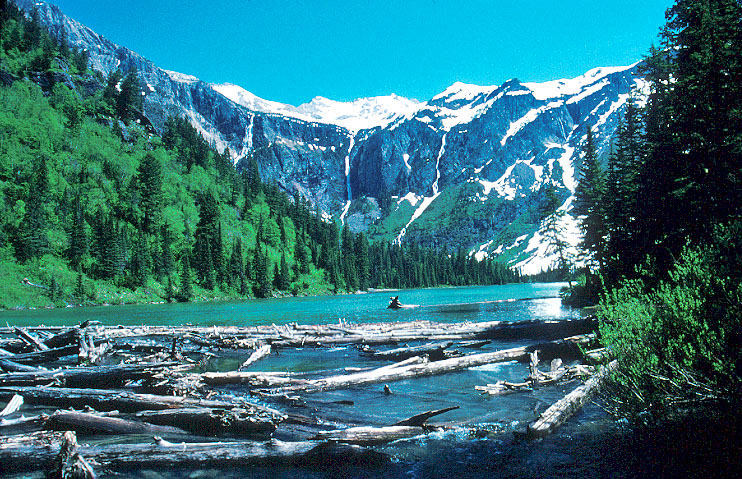
Avalanche
Lake, Glacier National Park, Montana |
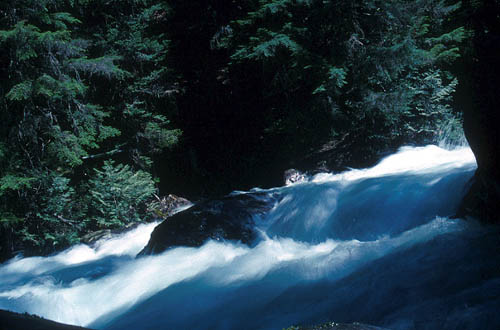
Avalanche Creek, Glacier National
Park, Montana |
|
Some mountain streams: These Montana streams are bigger than
headwater streams and begin to show some intermediate characteristics.
The surrounding forest is no longer as dominant, and as a result in-stream
production by algae is relatively more important than it is in
headwater streams. Aquatic insect communities now contain larger
numbers of grazers and filterers than were present in the
headwater streams. Snowmelt from adjacent alpine areas causes
significant flow in these streams, often for much of the summer. If
there has been a fire or clearcut in the watershed, the soil may erode
during these flooding events (see the picture of MacDonald Creek
below). Fish are common in most reaches of these streams, except those
above particularly high waterfalls.
For more on the
feeding strategies of aquatic organisms, particularly aquatic insects, look
here.
|
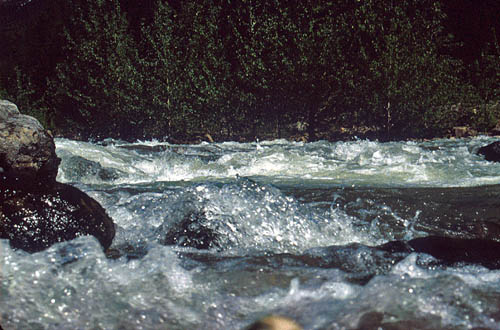
Avalanche Creek, Glacier National
Park, Montana |
|

Bear Creek, Montana |

MacDonald Creek, Glacier
National Park, Montana |
|

MacDonald Creek, Glacier
National Park, Montana |
|
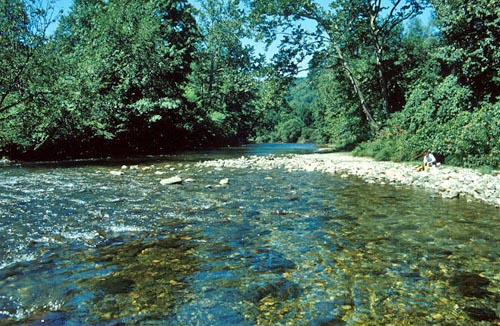
Battenkill River, Vermont. |
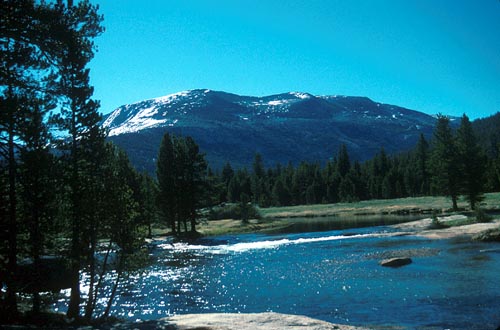
Tuolumne
Creek, Yosemite National Park |
|
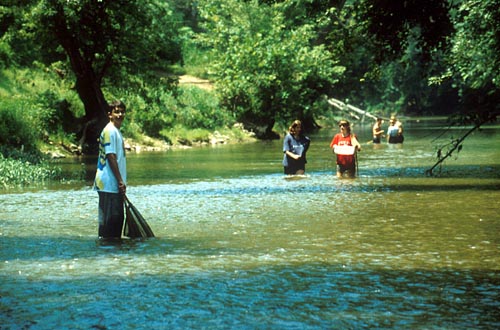
Little
Muskingum River, Dart, Ohio |
Higher-order streams: As streams
become even larger, moving beyond first and second order to 3rd and 4th
order, the forest canopy falls away and the stream is exposed to more
direct light. Grazers and scrapers become even more important at the
expense of shredders. Often these reaches of a stream my have the
greatest diversity. Note the clarity of the Battenkill River,
which supports extensive trout fishing. The water is about 1 meter
deep in the pool where the rocks on the bottom can be seen clearly.
People in Vermont have made a decision to protect the clarity of the
waters - and thus the tourist economy - by practical measures such as
restricting animal access to streams, not plowing to the edges of the
streams, restricting ATV's in streams, etc. The Little Muskingum
River, to the left, is the largest river in Ohio not affected by a
major city. The water is turbid as a result of unrestricted ATV use,
poor farming practices (including allowing cattle unfenced access to
tributary streams), poor construction practices, poor road-maintenance
practices, poor oil-and-gas well maintenance practices and the like.
Citizens in this watershed have resisted all attempts to help them come up
with their own solutions to these problems, and have resisted expansion of
the Wayne National Forest in the area. The local school
system is in desperate need of funding; rather than turning to
tourism as a possible solution the locals hold out for someone to come in
and turn the hills into a giant shopping mall or some other
revenue-generating operation. Recent history suggests that further
closings of industrial operations along the nearby Ohio River are more
likely than any great miracle of industrial/commercial activity. The Brule
River also supports healthy tourism/fishing; and the Tippecanoe
River runs clear despite flowing through some of the most intensely
farmed (and intensly conservative) land in the country. Isn't it
time to put conservation back into conservatism?
Soapbox ends .... now. |
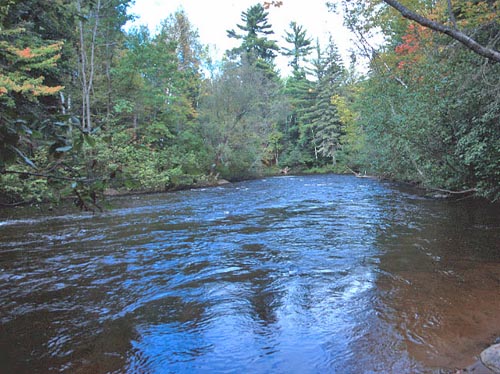
Brule River, Wisconsin
|

Tippecanoe River, Carroll County Indiana.
|
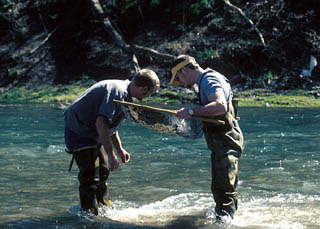
Little Muskingum River, Washington County, Ohio
|
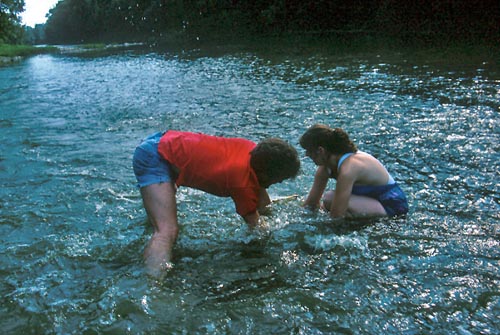
White River, Indianapolis, Indiana
|
 |
Monitoring Water Quality: One of the best
ways to monitor water quality is to directly monitor the benthic
macroinvertebrates (insects and other invertebrates that live on the
bottom of the stream). They are in the water 24/7, and unlike fish,
can't swim away during an episode of pollution. As a result, they
integrate and record water quality over the recent past. Also, it is
less expensive to monitor such populations than it is to run the large
number of chemical tests that would otherwise be required. The Ohio
EPA has led the nation in developing methods and standards for the use
of benthic macroinvertebrates (and other organisms) to monitor water
quality.
Above: Kick screens and Surber samplers
(left and right) are used to obtain qualitative (kick screen) and quantitative
(Surber sampler) samples of benthic macroinvertebrates.
Left: benthic macroinvertebrates in a sampling pan.
Top - a large stonefly nymph (Acroneuria sp.) dominates this
sample. A pair of amphipods is right in front of the
stonefly, the posterior of a dragonfly is visible, as is a smaller
stonefly. Bottom: a long slender damselfly larva (Calopteryx
maculata) is flanked by a pair of mayfly nymphs (Heptageniidae).
A water penny (Psephenus herricki) is on the bottom of the
pan under the damselfly. All of the organisms in these two
photographs are generally indicative of moderate to very good water
quality. Below right: A midge larva (Chironomidae).
The red color is caused by the presence of hemoglobin, which in turn
allows these larvae to exist in water with very low oxygen levels.
Presence of these larvae in large numbers is indicative of organic
pollution and attendant low dissolved oxygen. Worm-like organisms
are also better at living on silt-covered bottoms in streams affected by soil
erosion, the number one water pollution problem in the United
States today.
|
|
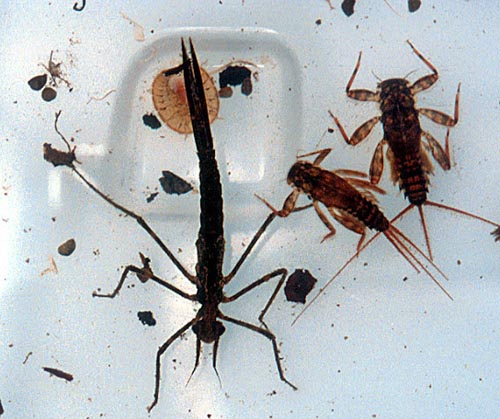
|
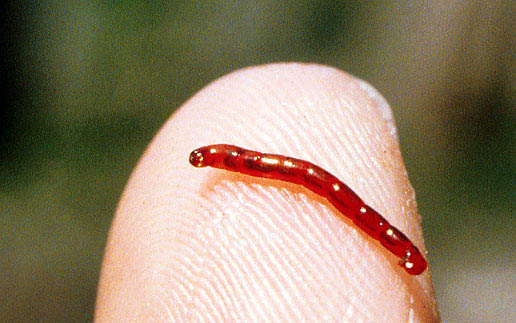
|
|
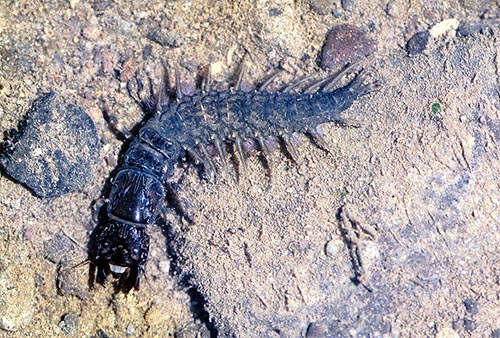
|
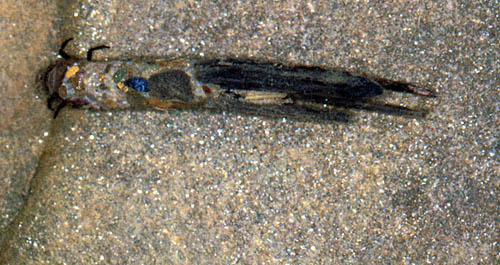
|
|
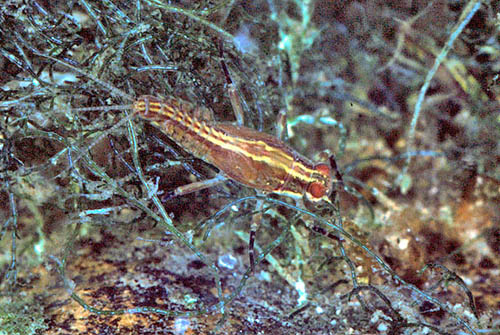
|
Benthic Macroinvertebrates, continued:
upper left - Corydalus sp., also known as a hellgrammite.
Hellgrammites are predators found in streams throughout the midwest.
Above right: A caddisfly larva. Caddisflies often build
cases from materials in their environment, here sand grains and twigs held
together by silk spun by the caddisflies. The case serves as mobile
protection while the caddisfly scrapes food from the rocks (or in other
species, while it shreds fallen leaves); the heavy materials in the case
also serve as ballast in strong currents. Left: Ephemerella
needhami, a mayfly larva living and feeding on Cladophora,
a filamentous algae often found in streams. Below left: a
scanning electron micrograph of Ephoron sp., a mayfly larvae
which burrows into the sediments of rivers. Below - Hydropsyche
sp., a caddisfly which does not build a case but rather spins a catchnet
of silk which it uses to filter food material from the water.
All of these insects are generally indicators of good water quality. |
|
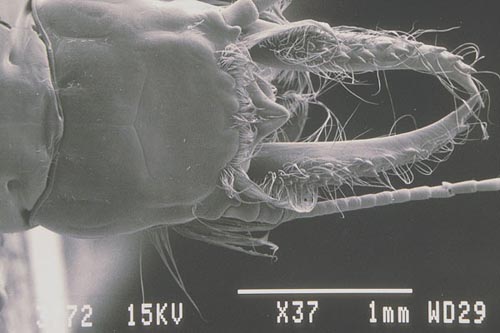
|
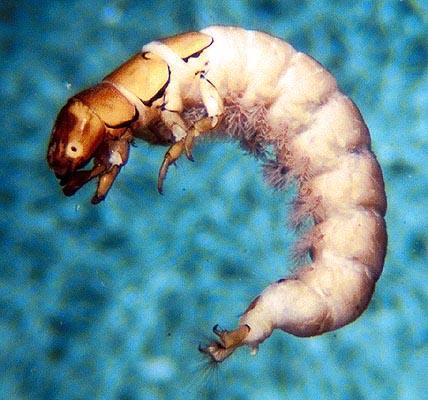
|
|
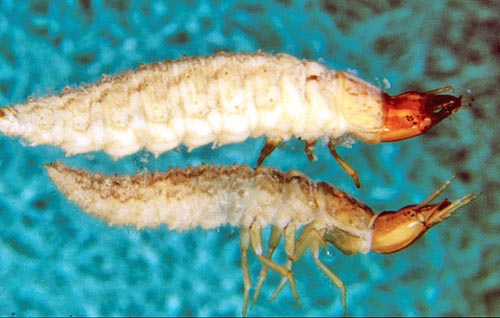
|
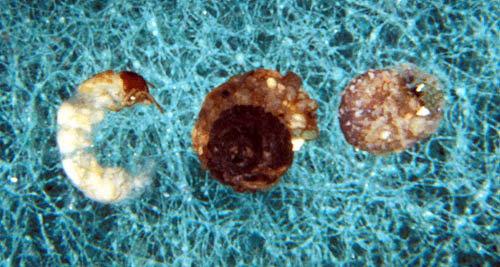
|
|
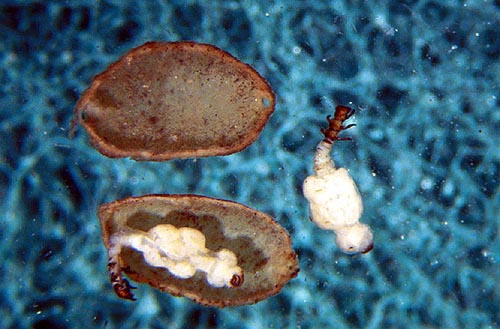
|
Still more benthic invertebrates: Above left, larvae of water
scavenger beetles, family Hydrophilidae. These beetles are
predators. Above, snailcase-making caddisflies, Helicopsyche
sp. which spin silk which they use to bind sand grains into cases which
resemble snail shells. These are tiny, only a few mm
across. Another tiny caddisfly is the purse-case making caddisfly
(Hydroptilidae), left. Here the case is almost completely silk,
containing a strangely shaped larva within. Below, two more species of
mayflies. On the left, Isonychia bicolor, a streamlined larva
which can be mistaken for a small bottom dwelling fish like a darter. Isonychia
filters food from the water using long hairs on its front legs. On the
right, below, is Apotamanthus sp., which uses its fierce-looking
mandibles as levers to move small rocks so that the larva can move under
them and filter or deposit feed. All of these species tend to be
found in clean water.
|
|
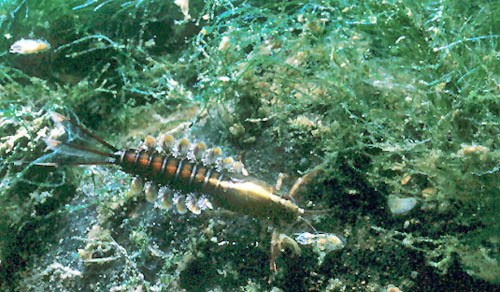
|

|
|
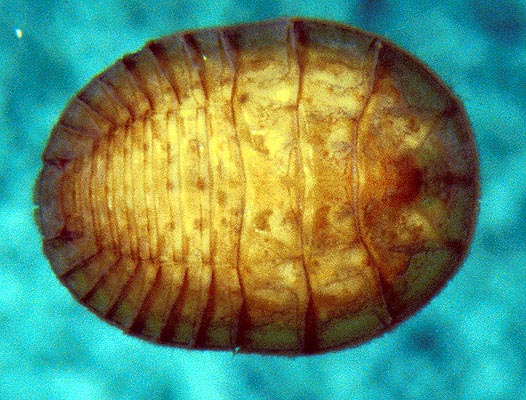
|
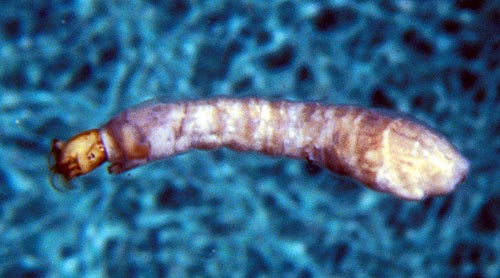
|
|
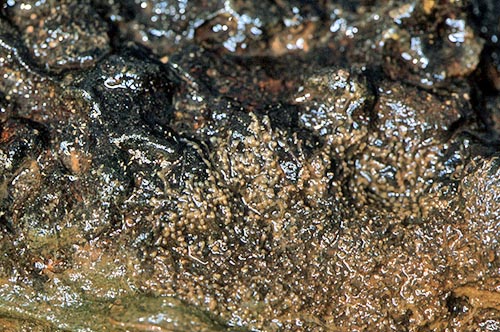
|
Above left: A water penny beetle
larva, Psephenus herricki. These flattened larvae can
crawl under rocks to hide; when out on the rock surface scraping off algae
they modify the flow of water around them making it easier for them to
stay in place and harder for fish to remove them. They do not do this by
suction as has been long suspected; but rather by gripping the rocks tightly
with their legs. They cannot hold onto a smooth glass surface, and
individuals with holes in their carapace (thus unable to produce suction)
are able to hold on perfectly well. All this and more in: McShaffrey,
D. and W.P. McCafferty. 1987. The behavior and form of Psephenus
herricki (DeKay) (Coleoptera: Psephenidae) in relation to water flow. Freshwater
Biology. 18:319-324.
Above right - a filter-feeding blackfly
larva (Simuliidae). Left: a colony of Bryozoa growing on a
rock. Somewhat coral-like, bryozoans are colonial filter
feeders. The two photos below show Obelia (left) and Plumatella
(right) in images made from stained microscopic mounts. In the
image of Obelia you can see the individual zooids 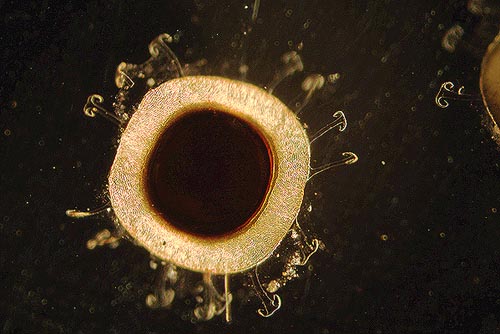 with
their filter-feeding tentacles as well as several reproductive
structures. The Plumatella below shows one zooid and
part of the colonial stalk. Some freshwater Bryozoa can form colonies
25 meters long and about 1-2 feet in diameter. with
their filter-feeding tentacles as well as several reproductive
structures. The Plumatella below shows one zooid and
part of the colonial stalk. Some freshwater Bryozoa can form colonies
25 meters long and about 1-2 feet in diameter.
The inset picture is of a statocyst,
a bryozoan reproductive structure used by freshwater species; over the
winter cells of the bryozoan survive in this tough shell and sprout a new
colonly the following spring. The hooks help it keep in place on the
stream bottom. |
|
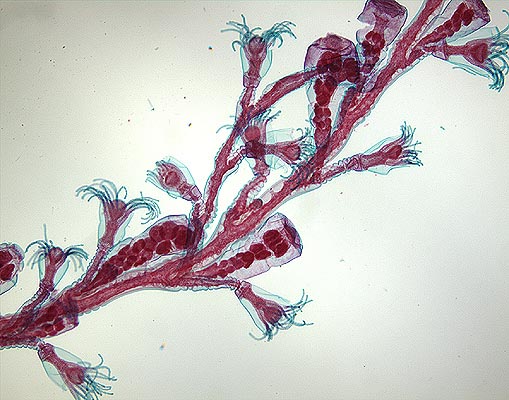
|
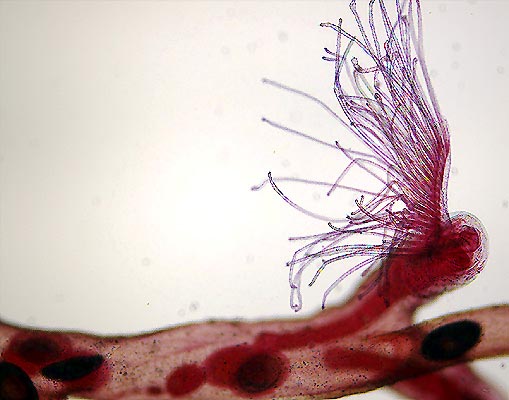
|
|
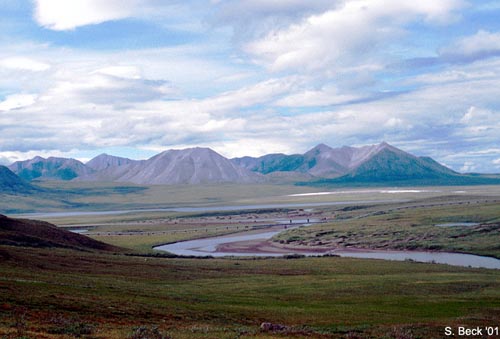
|
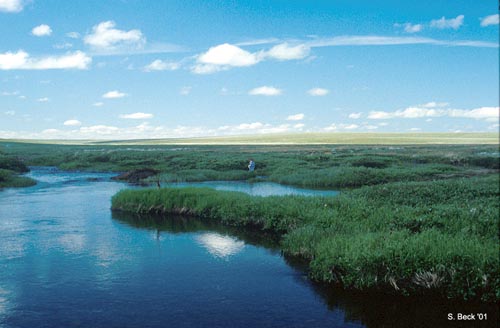
|
|
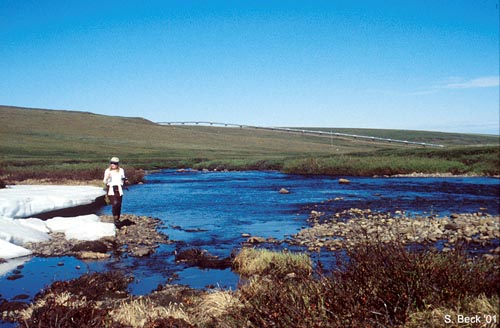
|
Arctic to Tropical: 3 images of streams in the Arctic tundra
of Alaska (note the Alaska pipeline in the background of the image at
upper left). These streams may only flow openly for a few weeks each
year as they drain the melting snow from the surrounding tundra. There
may well be considerable production taking place in the streams themselves
as there is obviously little shading and less obviously 24 hours of sunlight
in the brief summer. Photos courtesy of Sarah Beck (MC 2001).
Sarah spent a summer on a REU project (Research Experience
for Undergraduates) run by Woods Hole studying
production in tundra streams.
Below: subtropical rivers in Florida. Both
images are of Rock Spring Creek north of Orlando.
Like many southern "blackwater" rivers; this stream is low
gradient and has the water discolored by tannins leached from the
leaves of plants overhanging the stream.
|
|
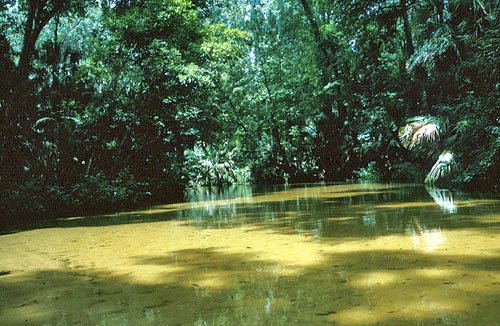
|
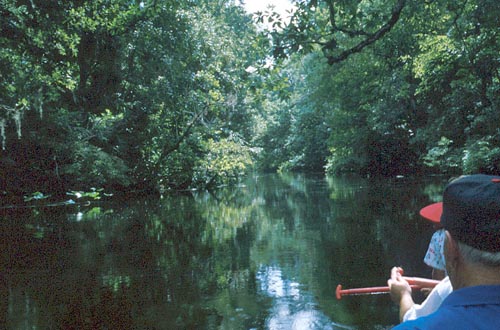
|
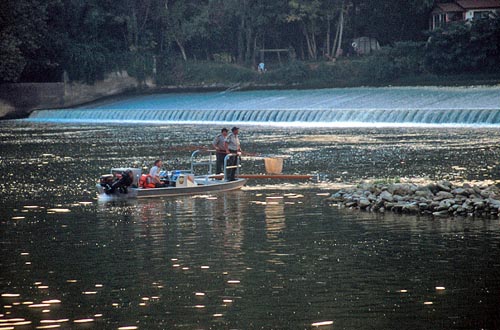 |
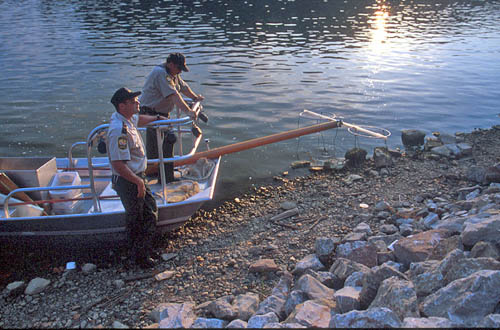
|
|
Fish, Part 1. Fish, of course, are a major component of most
stream and river ecosystems. Here we will look at some of the smaller, less
well-known fish. Above: electrofishing is an effective
way to study fish populations. An electrical current generated on the
boat is introduced to the water with the long nets or with a boom sticking
out from the boat. Fish in the water are stunned and dipped out of the
water. Once caught, they can be identified, measured and returned to
the river. Smaller electrofishing units can fir in a backpack fro
smaller streams (wearing waders is definately a good idea). Right: a
small darter, a bottom dwelling insectivorous fish. Below
right: a Bluntnose Minnow, Pimephales notatus, below, an Emerald
Shiner, Notropis atherinoides atherinoides. Both were
caught in tributarieds of the Little Muskingum River in Washington County,
Ohio. Both feed on aquatic insects and smaller fish.
|
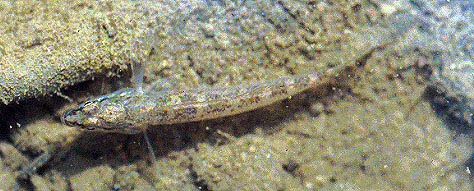
|
|
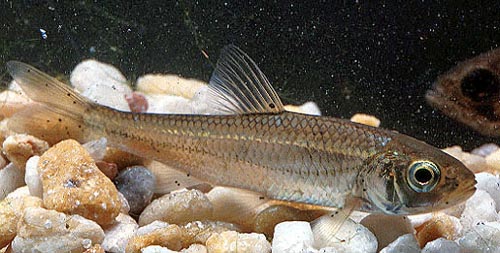
Emerald Shiner, Notropis atherinoides
atherinoides
|
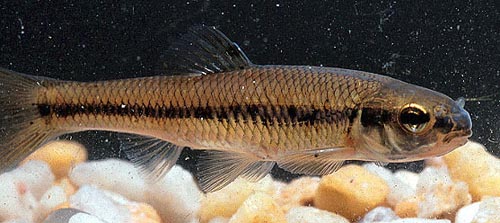
Bluntnose Minnow, Pimephales notatus |
|
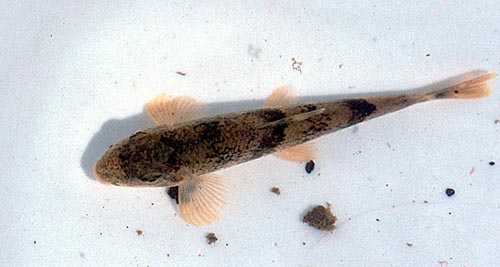
Northern Hog Sucker (Hypentelium nigricans) |

Johnny Darter (Etheostoma
nigrum) |
|
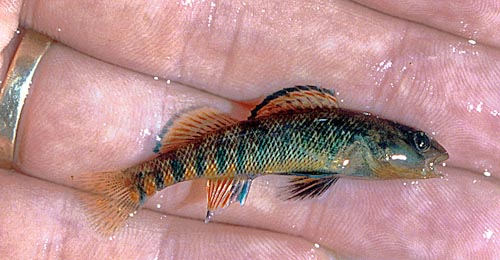
Rainbow Darter (Etheostoma caeruleum)
|
More fish from smaller southern Ohio streams:
The Northern Hog Sucker and the Stoneroller are both bottom dwellers,
the hog sucker feeds on insects while the stoneroller feeds on attached
algae. The two darter species are both insectivorous and
require clean streams with gravel or sand bottoms. The rainbow
darter is a male in its breeding coloration. The Redbelly Dace
also feeds near the bottom, but does not rest on it; it eats aquatic
vegetation and algae.
You can read more about various fish species here:
http://www.ohiodnr.com/wildlife/Fishing/aquanotes-fishid/fishtips.htm |

Southern Redbelly
Dace (Phoxinus
erythrogaster)
|

Stoneroller (Campostoma
anomalum)
|
|
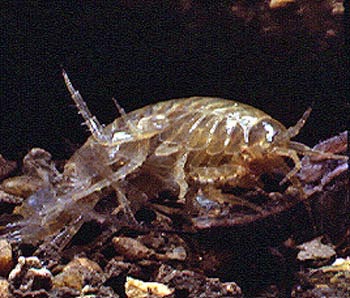
Scud (Amphipoda)
|
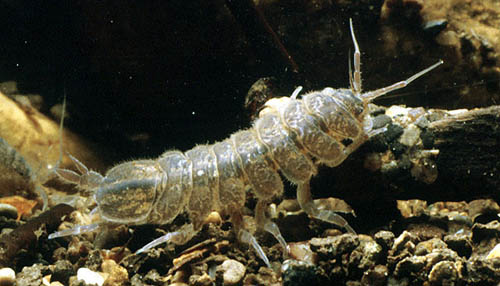
Assellus sp. (Isopoda)
|
| Scuds (order Amphipoda) and Assellus
sp. (order Isopoda) are small crustaceans common in streams,
particularly small streams where they are both often associated with leaf
packs. Both are shredders, and feed on leaves and other such
organic material placed into a lake. Mussels feed at the
smaller end of the food chain; they filter tiny bits of material out of
the water. Some of this can be in the form of algae or other
plankton; other food for the mussels may be so-called fine-particulate
organic matter (FPOM, 250-1000 micron particles). North America
is the world center of mussel diversity, and small areas below century-old
dams on the Muskingum River in Ohio are among some of the most
diverse mussel beds left, with a high proportion of federally listed
endangered species contained in these relatively small areas.
Individual mussels can live for over 50 years. For more on mussels
see:
http://www.marietta.edu/~biol/mussels/1stpg.html
|
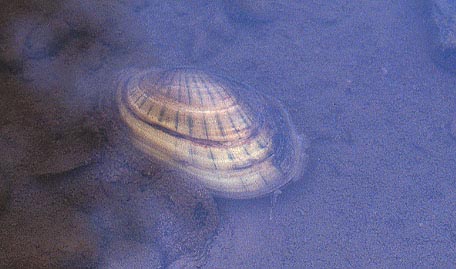
Mussel
|
|
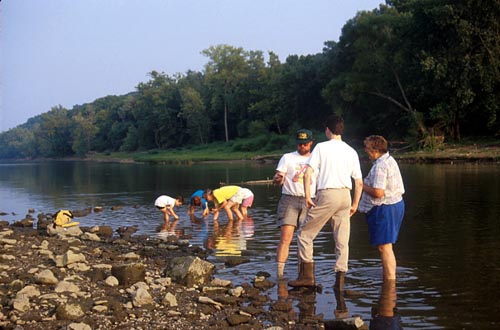
Mussel bed at Devola, Muskingum
River
|
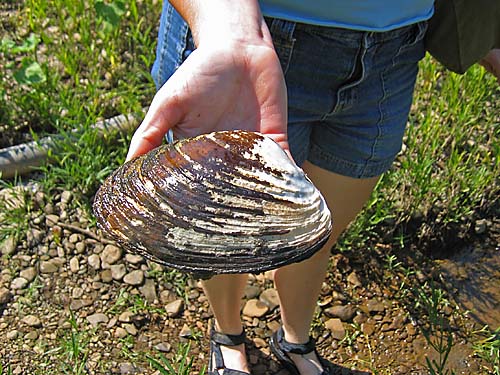
Mussel
|
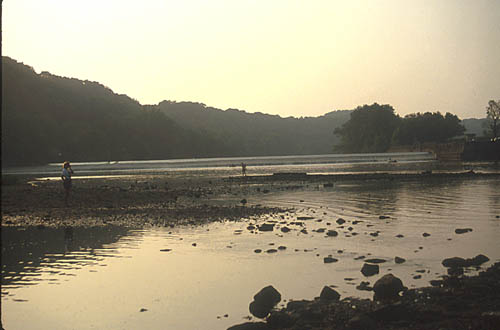
Mussel bed at Devola, Muskingum River |
|
Crayfish are small crustaceans
that occupy many streams and rivers in North America and other parts of
the world. They resemble their saltwater cousins the lobsters (and
are also tasty, but it takes a lot to make a meal). Many live under
rocks in rivers and streams, others burrow into the banks of
streams, rivers, ponds, ditches, wetlands and the like. Often these
burrows will extend from the surface down to the water table; the upper
entrance of the burrow may be surrounded by a "chimney" of
excavated dirt. Other organisms, including a federally endangered
dragonfly larva, live in crayfish burrows. |
 |
|
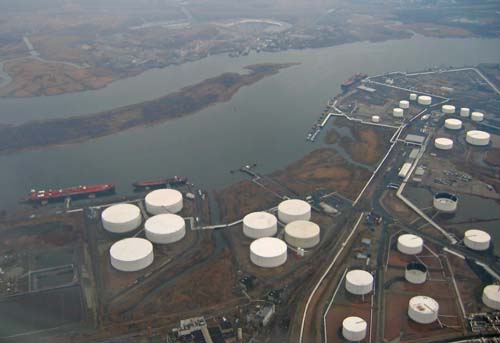
Industrial
waterway, Newark, New Jersey |
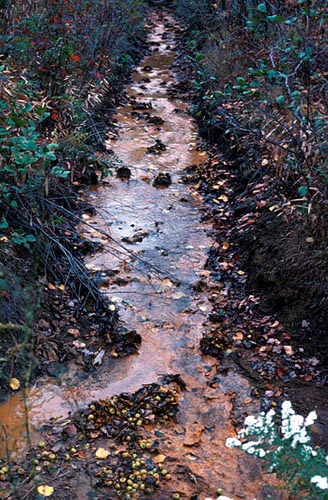
Acid Mine Drainage, Ohio
|
|

Seine River, Paris (as seen from
the Eiffel Tower) |
Water pollution affects streams and rivers of all sizes. In
eastern Ohio and other places where coal mining has occurred,
minerals from underground can become oxidized at the surface and in the
process give off acids that lower the pH of streams and lead to acid mine
drainage, which can have a detrimental effect on stream life. The
pH of the pictured stream was about 1, and the water sample had to be
diluted 10,000x before iron levels could be measured. Many cities are
built near water, and the industrial activities that take place on the
waterways pose the risk of contamination (Newark, above left); often
the nature of the stream is completely changed as a result of engineering on
the banks (Paris, left). Coal plants are often built on
rivers both for convenience in obtaining cooling water and for low cost of
coal transportation. Beyond the footprint of the plant itself,
however, there are a number of ecological ramifications that spread to the
surrounding countryside. Powerlines cut swaths through forests,
coal mines impact the land and streams, landfills are used to bury fly ash,
and of course the long-distance impacts of global warming and acid
rain. Warm water added to streams affects stream life in several ways;
for one, warm water holds less oxygen and organisms in warm water respire
more (and thus require more oxygen).
|
|
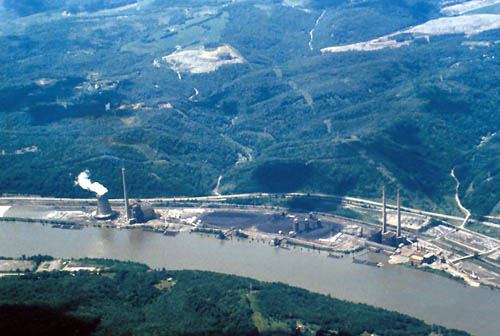
Power Plant at Brilliant, Ohio on
the Ohio River
|
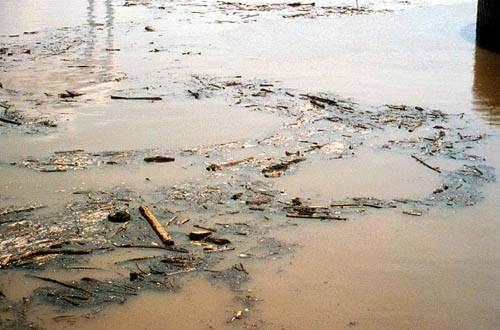
Debris on the Ohio River |
|
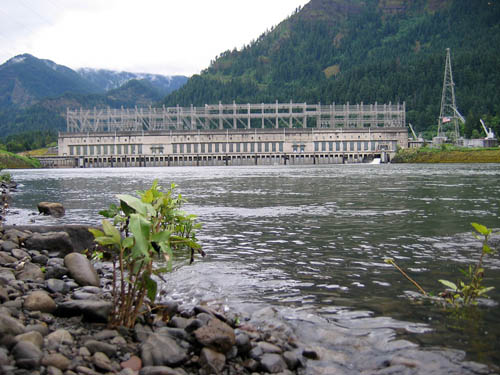
Bonneville Dam, Columbia River |
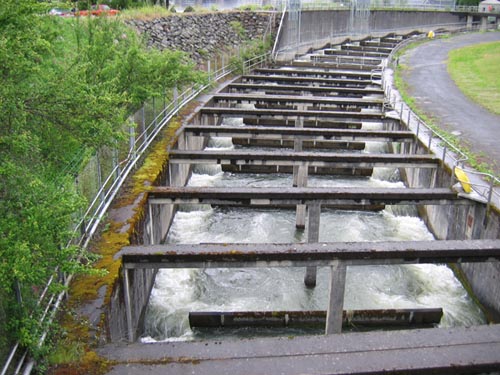
Fish
Ladder, Bonneville Dam |
Dams are built on streams for many
reasons - to hold water for irrigation and drinking, to generate power, to
create lakes for recreation, to mitigate floods, and for navigation.
The Bonneville Dam on the Columbia River (above) generates
power and provides for navigation. One big problem with dams is that
they block fish from moving upstream. Many fish are anadromous;
they live in the ocean and return upstream to spawn. In the
northwest, salmon are a conspicuous and important anadromous
species. To allow salmon to bypass the dams, most are provided with
fish ladders (right). This allows fish like the Rainbow Trout
(Oncorhynchus mykiss) and the White Sturgeon (Acipenser
transmontanus) (below) to make it upstream to spawn.
Unfortunately, it also allows fish like the sea lamprey (below,
below right) to reach its spawning grounds; in the Great Lakes, completion
of the Welland Ship Canal from Lake Erie to Lake Ontario in 1829
allowed the lampreys access to the upper Great Lakes. Sea Lampreys
contributed to the decline of many commercially important fish species in
the Great Lakes as they feed by latching onto the sides of such fish.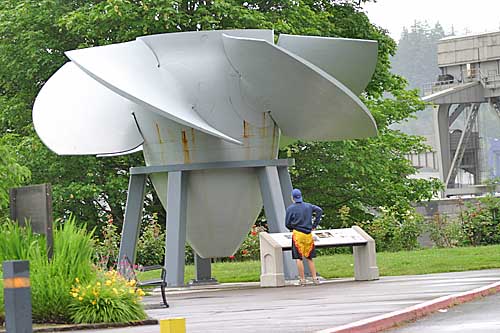
Another problem dams cause fish is on the downstream side.
Juvenile salmon are ground up in the turbines (left) which power
the generators; in addition the water downstream from the dam is so frothy
that fish (and even human swimmers) cannot stay afloat. To get
around this, the Army Corps of Engineers actually rounds up the juvenile
fish and barges them downstream (really - see the picture below) |
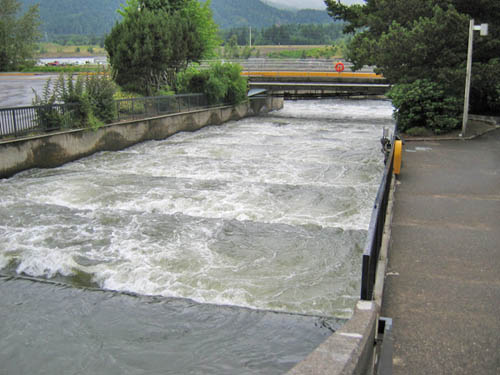
Fish Ladder, Bonneville Dam |
|
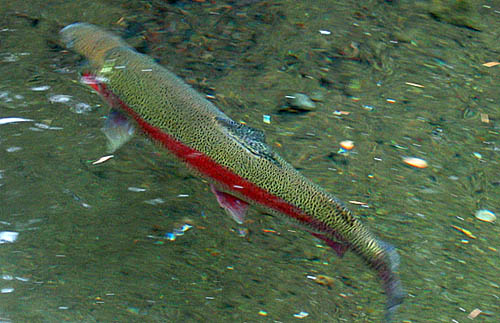
Rainbow Trout (Oncorhynchus mykiss) |
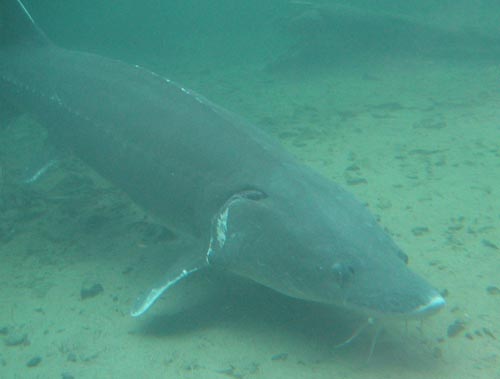
White Sturgeon (Acipenser transmontanus) |
|
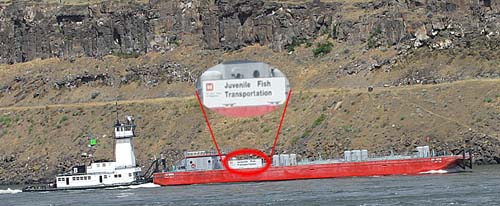
Juvenile
Fish Transportation Barge, Columbia River |
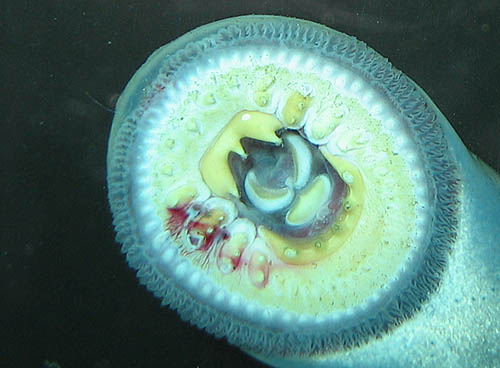
|
|
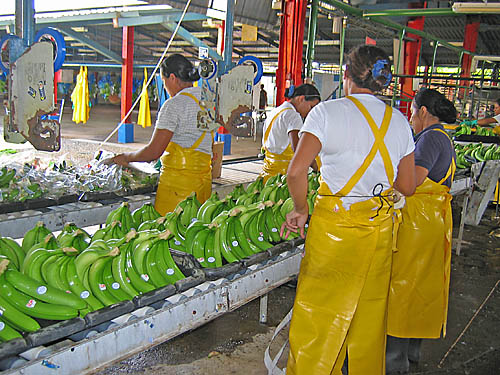
Banana processing plant, Costa
Rica |
To avoid pollution coming from
its banana processing plant at Finca Zurqui in Costa Rica, Dole Fruit
Company installed a small water treatment plant. I'm not sure this
mitigates all the chemicals sprayed on the field, but it's a nice gesture. |
|
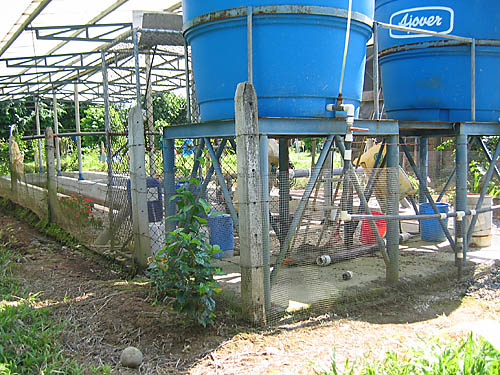
Water
Treatment Plant, Costa Rica |
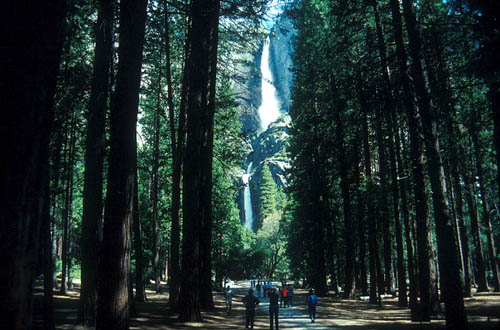
Yosemite Falls, Yosemite National Park,
California
|
|
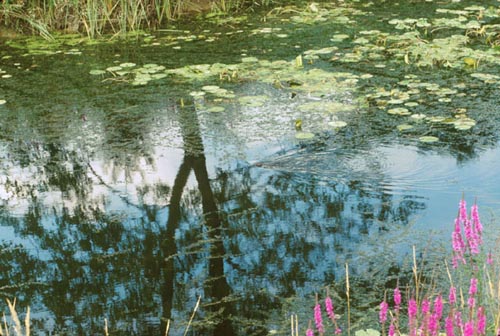
Ohio and Erie Canal, Canal Fulton,
Ohio |
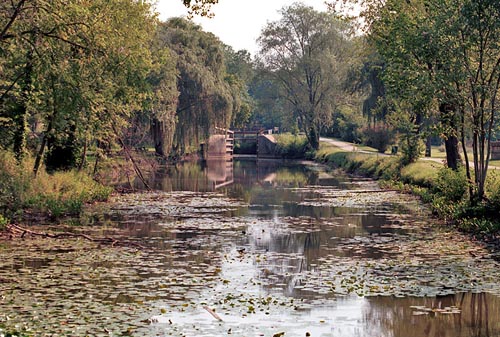
Ohio and Erie Canal, Lock 4, Canal Fulton, Ohio
|
| Streams and rivers have long been used for
transport, recreation, and sources of food. The Ohio and Erie
Canal in Ohio is but one of the many canal systems built in the United
States before the era of rail and road. Canoeing and kayaking
are popular recreational activities today; in the past these were the
preferred means of transport and exploration. The Ohio River is
still a major transport route; its tributary, the Muskingum River is still
canalized, with a system of dams that today are only historical in
nature. Stony Brook on Cape Cod was extensively modified to
power a nearby grist mill - and for herring fishing. When the
herring made their annual run, residents could scoop them easily out of
this modified streambed.
|
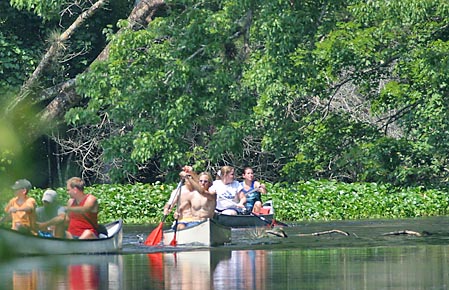
Canoeing, Wekiva River, Florida |
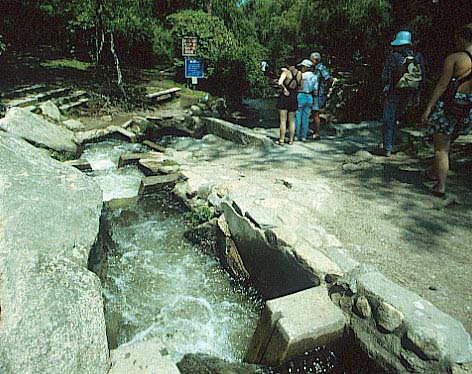
Stony Brook, Cape Cod
|
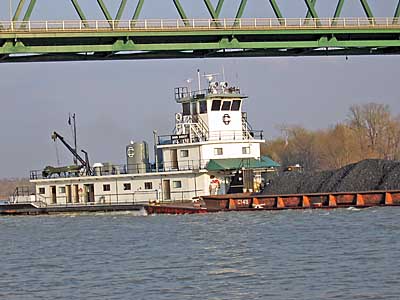
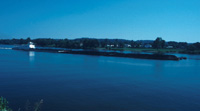
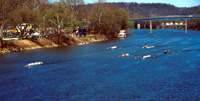
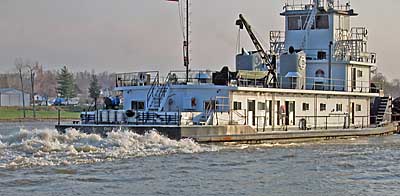
Coal Transport and Crew - Ohio River and
Muskingum River, Marietta, Ohio
|
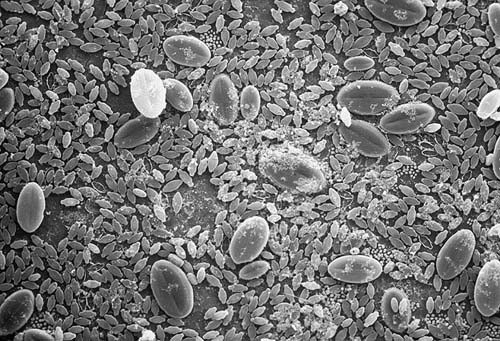
Diatoms (Cocconeis and Navicula
sp.)
|
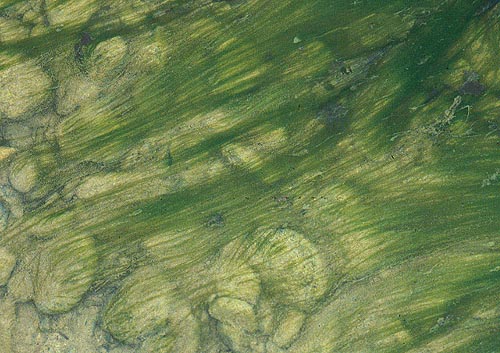
Cladophora growing in a stream.
|
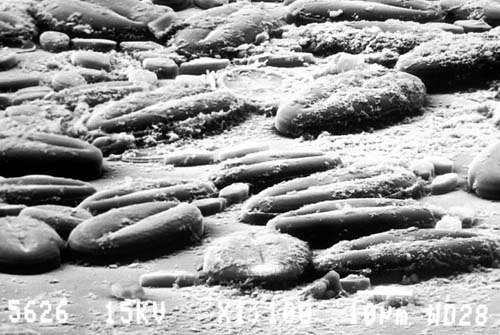
Diatoms (Cocconeis and Navicula
sp.)
|
Top and Bottom of the food chain in streams. Diatoms
(Scanning Electron Micrographs, left) are small algae with shell of silica.
Free-living in the water, or attached to the substrate as these are,
diatoms are a major food source for organisms in streams. Attached
diatoms are removed by scrapers among the herbivores. Cladophora
(above) is a filamentous algae that grows in streams.
Below, otters are small carnivorous mammals that
are often the top predators in streams. Feeding at will on mussels,
fish, turtles, frogs, etc., otters are also known for their playful
antics. River Otters released in Ohio to help the species recover
from extirpation due to trapping have been known to leave the streams and
wander inland for miles to raid fish farms. |
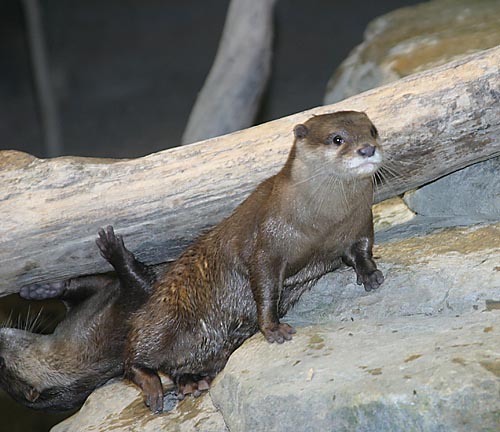
Otter at a zoo.
|
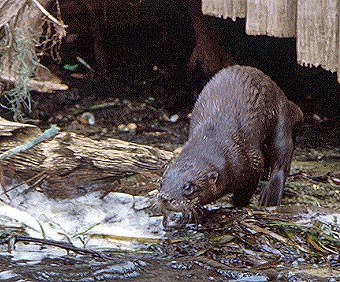
River Otter (Lutra canadensis), Lake
Eloise, Florida.
|
|
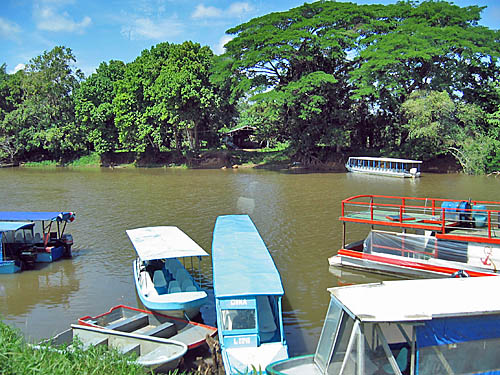
Caņo
Negro, Costa Rica |
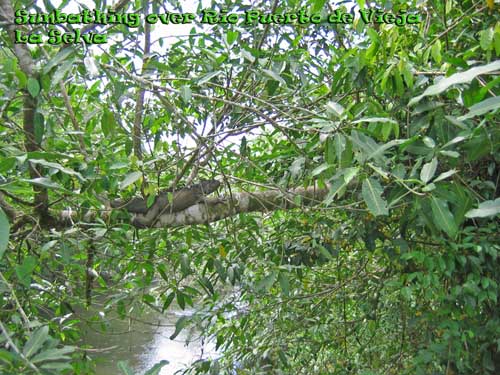
Rio Puerto Viejo, La Selva Costa Rica
|
|
Tropical Rivers: Caņo Negro, above, is
crowded with tropical wildlife - and the tourists which come to see the
wildlife. Low-gradient tropical rivers (the Amazon and its
tributaries being the prime examples) are still important transportation
routes.
In 2005, we were privileged to stay for several days on
the Rio Puerto Viejo at the La Selva Biological Station.
This river is a good example of a mid-sized tropical river. These
rivers - whether headwater streams (right) or Rio Puerto Viejo itself -
are similar to temperate streams in terms of the relative importance of
in-stream vs. out of stream production and other factors. On the
other hand, tropical rainforest streams receive a constant flow of leaves
over the course of the year, and the canopy never opens up (in the
springtime) to allow algae to thrive in the streams.
|
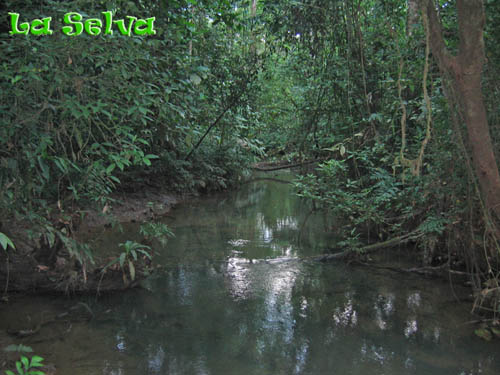 |
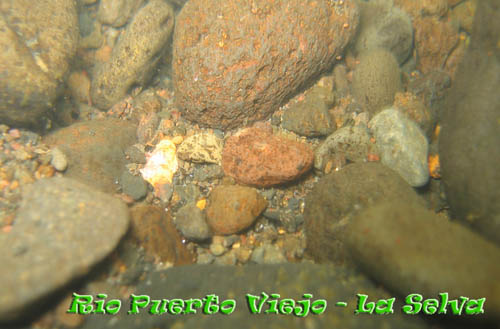 |
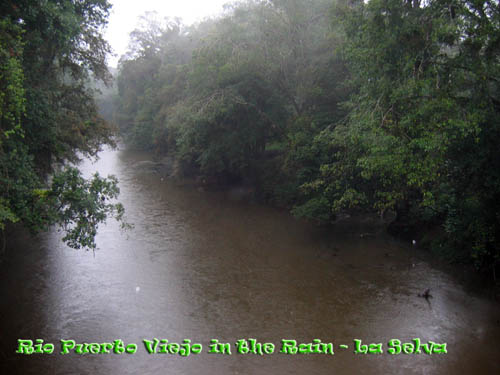 |
|
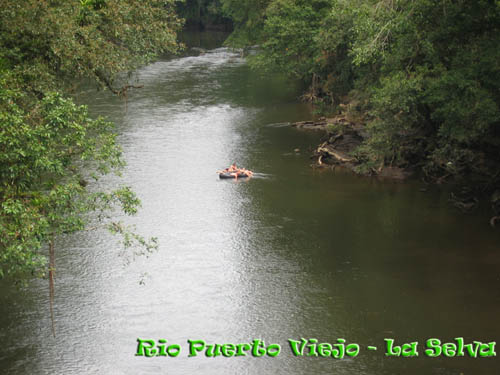
|
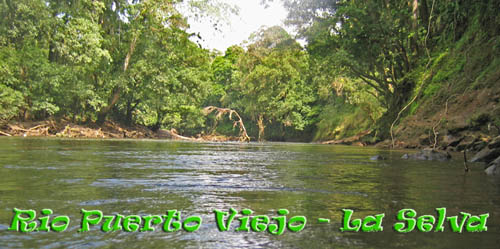 |
|
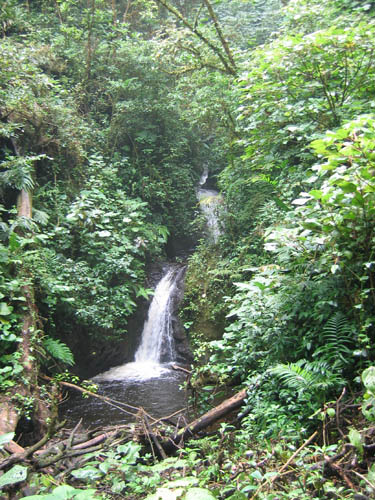
Monteverde Cloud Forest |
Headwaters to mid-sized streams:
Headwater streams in the tropics also resemble their temperate
counterparts in many ways. One important difference, however, is the fact
that the rainfall (at least in rainforests) may be much more constant over
the course of the year, and at least in Costa Rica there is no snowmelt to
speak of!
Larger streams may show watercourses more indicative of differences
between rainy and dry seasons. This river in Costa Rica (below,
right) is shown just at the beginning of the rainy season. |
|
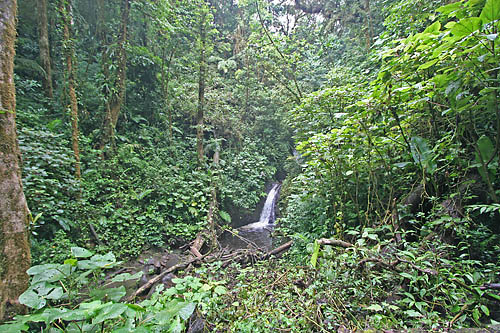
Monteverde Cloud Forest |
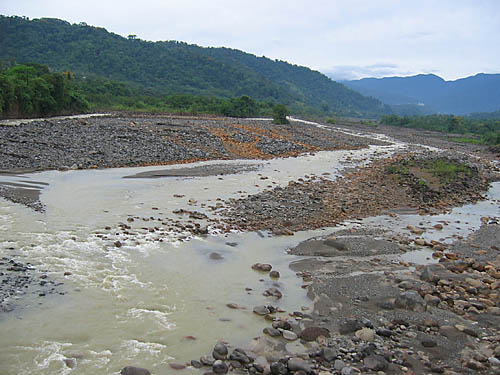
River, Costa Rica |
|
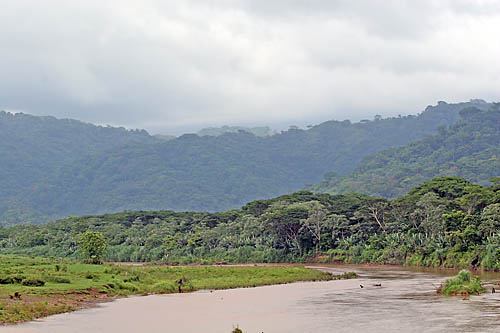
Rainy season - Rio Grande
de Tarcoles |
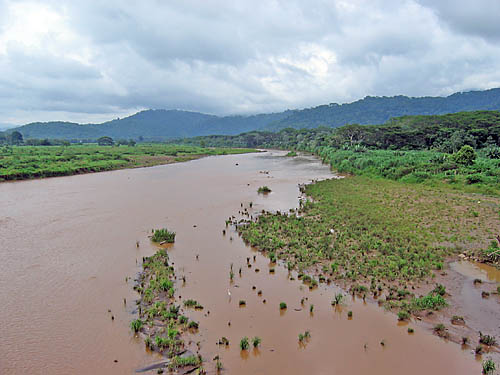
Rainy season - Rio Grande
de Tarcoles |
| At the beginning of the rainy season, the Rio
Grande de Tarcoles (above) is just beginning to swell. These
pictures, taken near the mouth of the river on the Pacific Coast, show the
river bearing silt from upstream.
To the right and below are small streams in the Rincon de la Vieja
National Park in Costa Rica. This is montane rain forest rather
than lowland rainforest. The ground is volcanic, as the park is on
the slope of a volcano. These steep gradient streams flow clear down
the hillside.. |
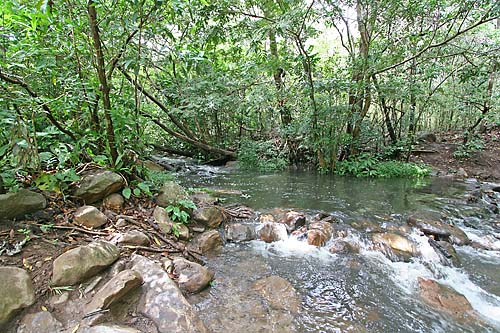
|
|
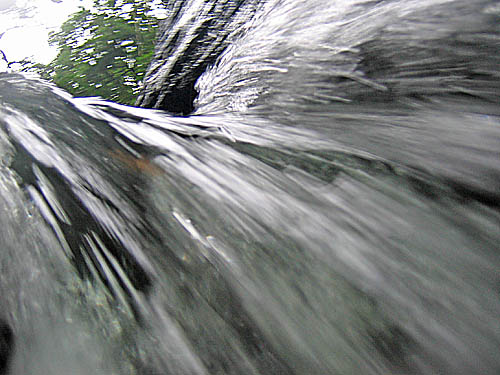
|
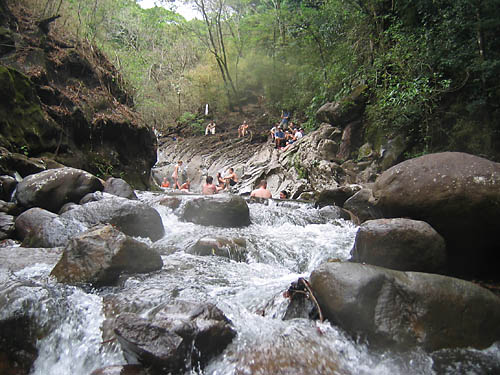
|
|
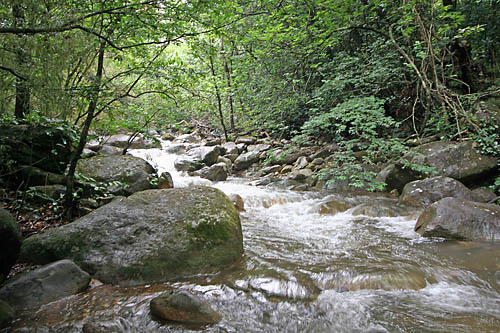
|

|
|
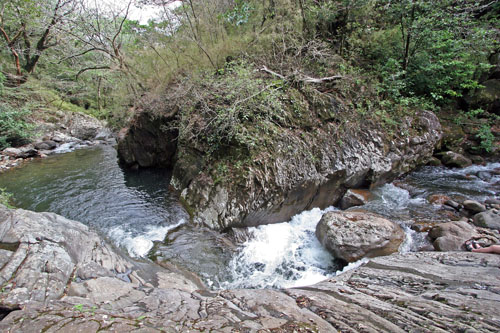
|
More views of small streams in Rincon de
la Vieja National Park, Costa Rica. |
|
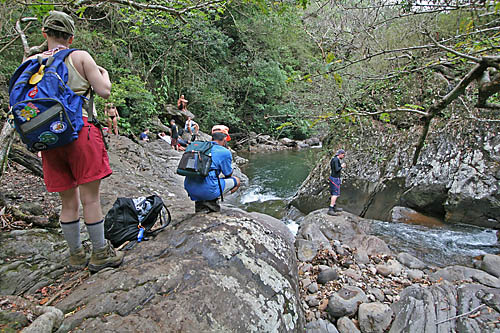
|
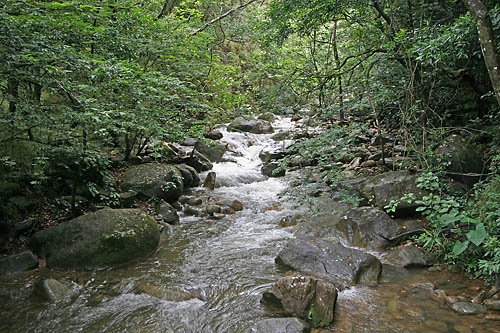
|
|
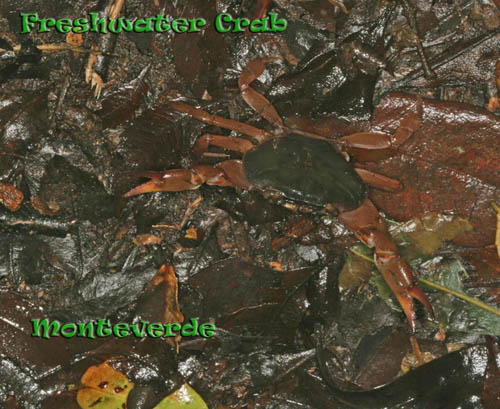
Freshwater Crab, Monteverde Cloud
Forest, Costa Rica |
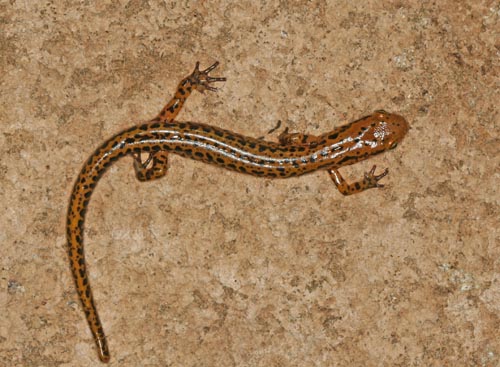
Longtail Salamander, Eurycea longicaudata |
| Above - One of the most conspicuous differences
in streams between the tropics and the midwestern United States is the
presence of crabs in the streams in the tropics.
Right - Longtail Salamander, Eurycea longicaudata, a
beautiful salamander found in streams in eastern Ohio. Salamanders
often play the role of top predators, particularly in small streams
without fish. Below right, the mudpuppy, Necturus maculosus
maculosus is a neotanous (retains its gills throughout life)
salamander that lives its whole life in water.
Below - the Muskingum River at Stockport, Ohio. This dam,
built in the 1800's, persists today. You can see the hand-operated
navigation lock on the far bank; the near bank holds a mill and has
variously seen service as a restaurant and bed and breakfast, and the
turbines have recently been used to generate electricity.
|
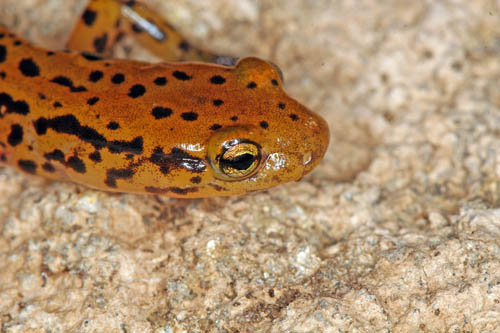
Longtail Salamander, Eurycea longicaudata |
|
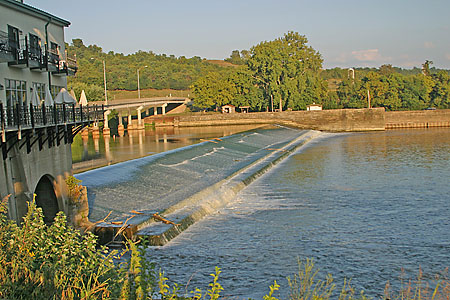
Muskingum River at Stockport, Ohio |
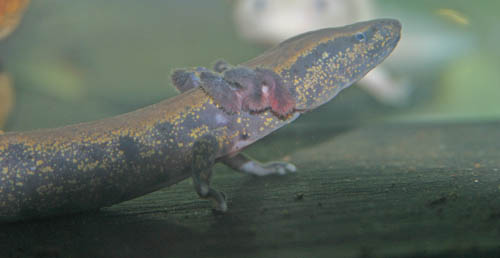
Mudpuppy, Necturus maculosus maculosus |
|
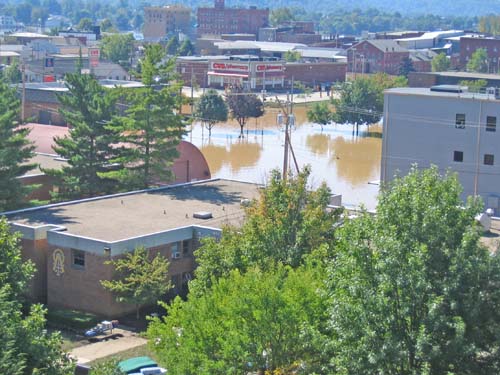
|
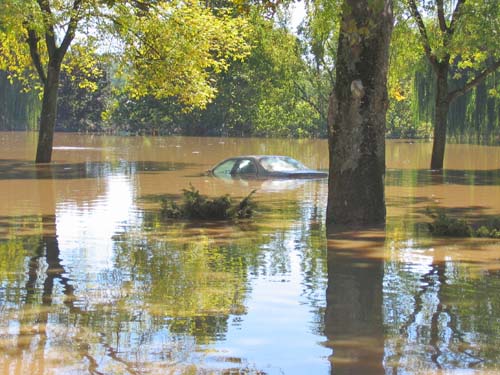
|
|
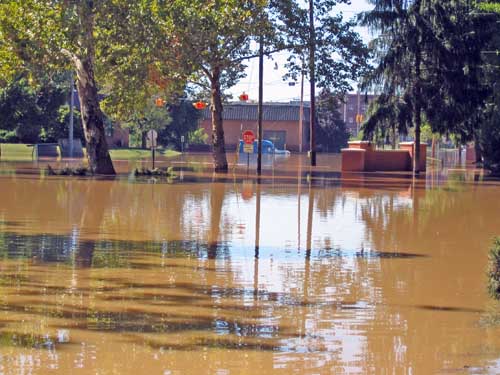
|
Floods are part of living near any river.
This unusual summer flood hit Marietta in September 2004 as the remnants
of a 3rd hurricane in a two-week period (Charley, Frances, Ivan) reached
the Ohio Valley with significant rain. These pictures are of the
flood on the Marietta College Campus; the school was closed for a
week while student, faculty and staff volunteers cleaned and rebuilt the 3
dorms which were flooded. Floods like this normally hit Marietta in
the winter. The Army Corps of Engineers and the Muskingum Watershed
Conservancy district operate a number of flood control structures upstream
to minimize floods; ironically the navigation dams on the Ohio River that
keep the river level high enough for barges probably contribute to the
flooding Marietta now gets.
Below - in Costa Rica, even a small flood can have some real
consequences. |
|

|
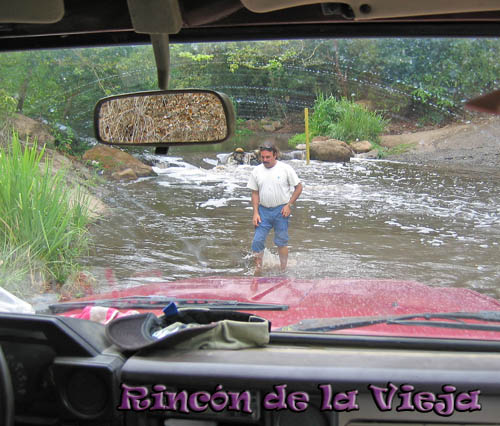
|
|
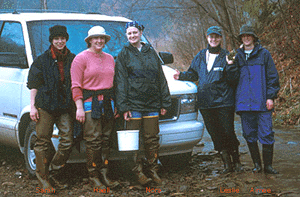
|
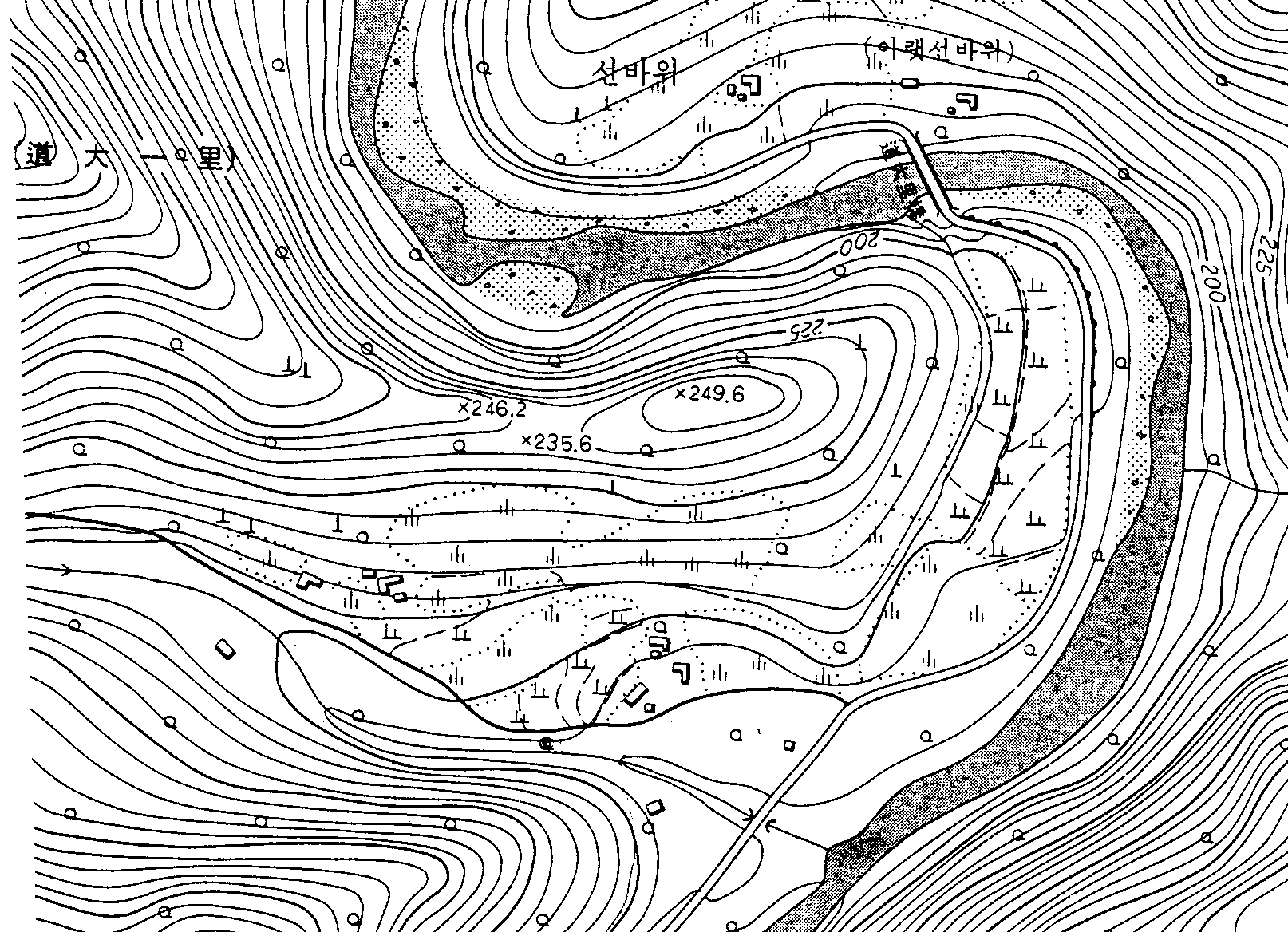
|
|
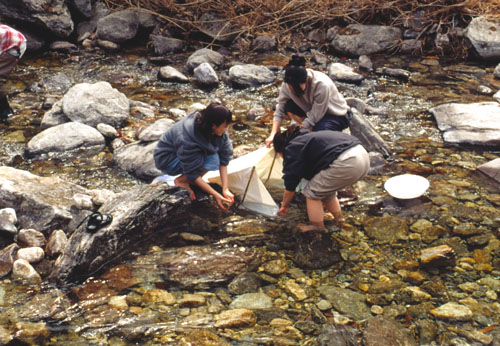
|
Marietta College has
an exchange program with Seoul Women's University in Korea.
As a part of this exchange, students from both colleges have studied their
local streams and compared results over the internet with their colleagues
at the other institution. Above left - a Marietta College team
studying Baker Run. Above right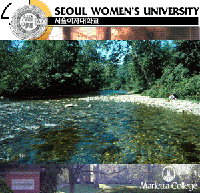 :
map of the Kapyong Creek site in Korea. Left - Korean
students sampling in Kapyong Creek. Below: Kapyong Creek and Korean
Mayfly. :
map of the Kapyong Creek site in Korea. Left - Korean
students sampling in Kapyong Creek. Below: Kapyong Creek and Korean
Mayfly.
Web site for the project:
http://www.marietta.edu/~biol/Korea/
|
|
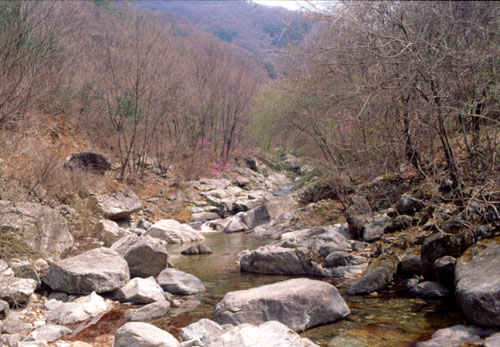
|
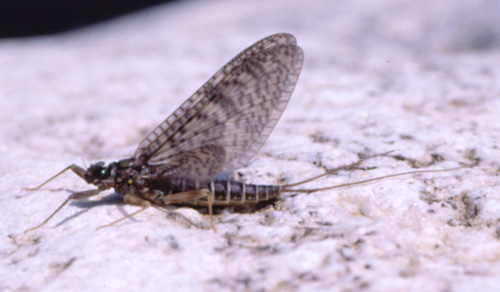
|
|
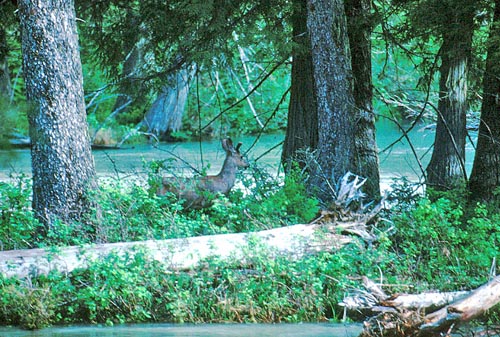
MacDonald Creek, Glacier National
Park, Montana |
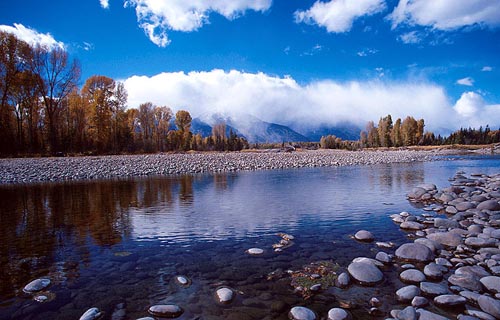
Snake River, Wyoming
|
|

Yosemite
Falls, a barrier to upstream migration of fish. |
Some pretty pictures to finish
this section out. |
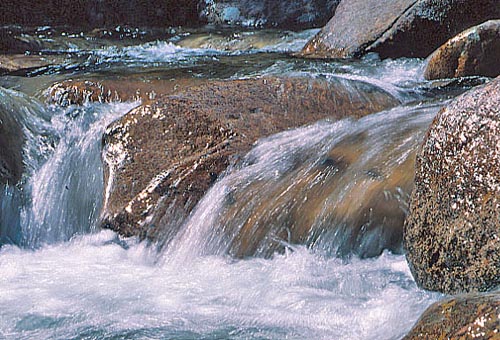 |
|
|
| If you
haven't seen the section on lakes yet, perhaps this is a good time to go
there. |



































 with
their filter-feeding tentacles as well as several reproductive
structures. The Plumatella below shows one zooid and
part of the colonial stalk. Some freshwater Bryozoa can form colonies
25 meters long and about 1-2 feet in diameter.
with
their filter-feeding tentacles as well as several reproductive
structures. The Plumatella below shows one zooid and
part of the colonial stalk. Some freshwater Bryozoa can form colonies
25 meters long and about 1-2 feet in diameter.


















































































 :
map of the Kapyong Creek site in Korea. Left - Korean
students sampling in Kapyong Creek. Below: Kapyong Creek and Korean
Mayfly.
:
map of the Kapyong Creek site in Korea. Left - Korean
students sampling in Kapyong Creek. Below: Kapyong Creek and Korean
Mayfly.









